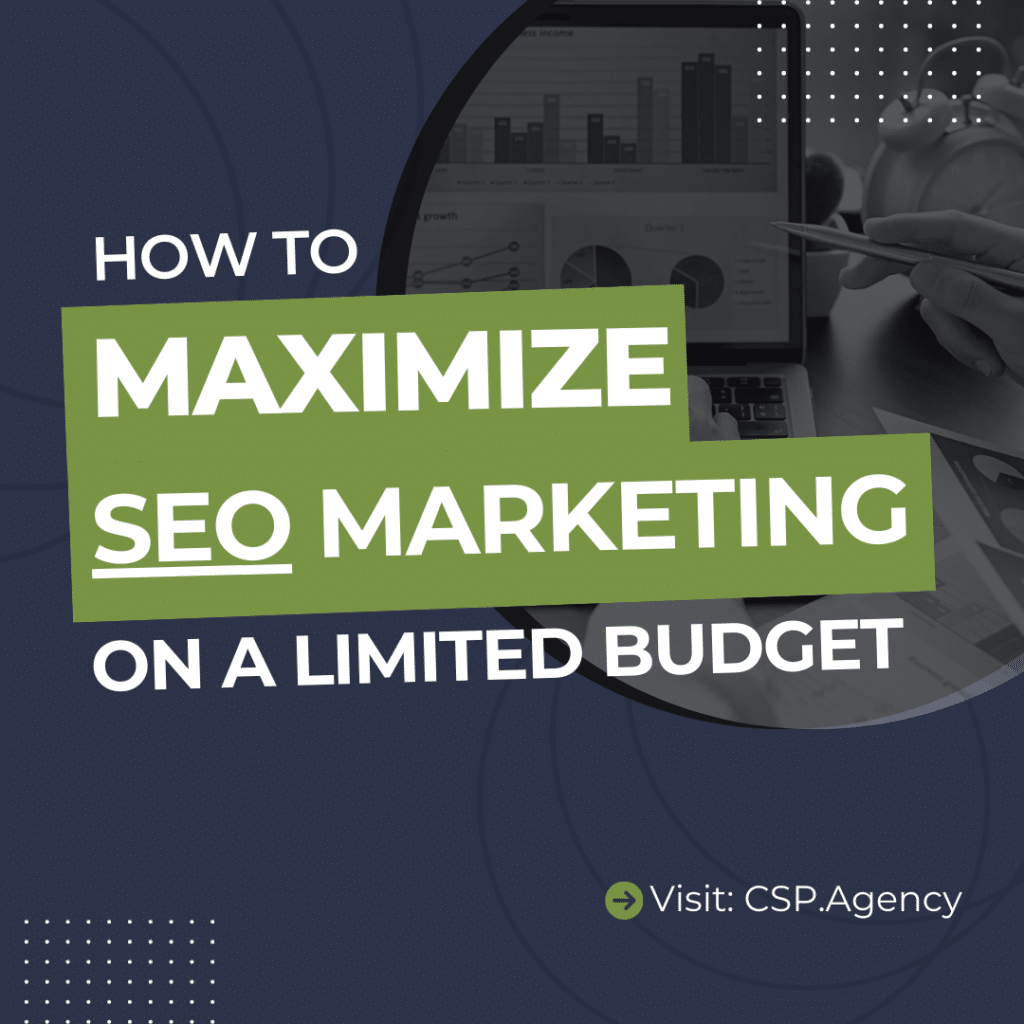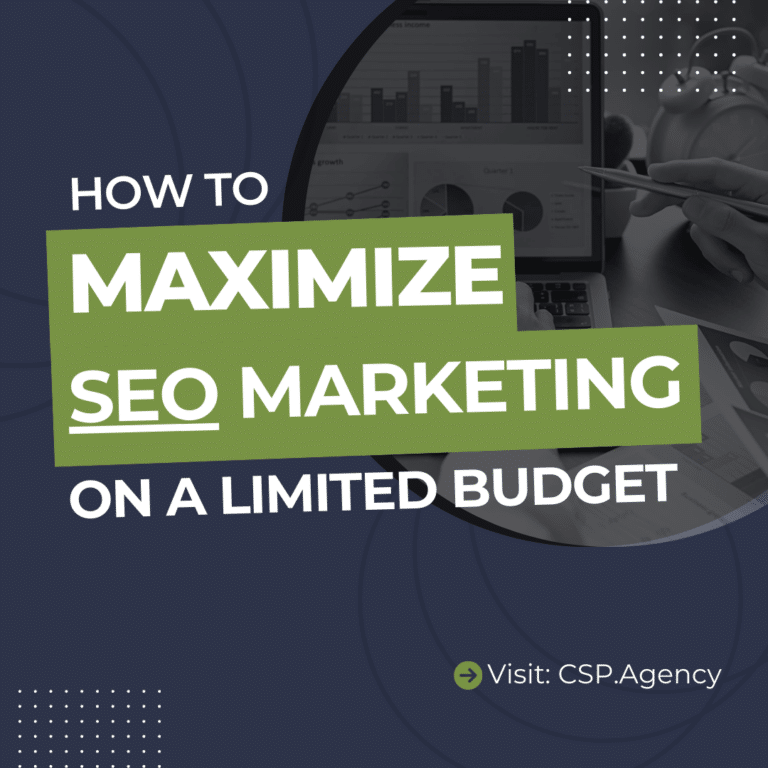When your marketing budget isn’t as roomy as you’d like, don’t cut SEO—learn how to maximize your efforts and do it on a smaller budget. SEO doesn’t have to be expensive to be effective. Low-cost, high-performing SEO tactics and learning where you can afford to cut spending without harming your discoverability in search make it possible to keep your SEO efforts running like a well-oiled machine, even in the face of budget cuts.
Check out a few ways to maximize SEO strategy development when the purse strings tighten with the right strategic focus for your brand’s goals and budget.
How To Maximize SEO When Budgets Are Tight
Should I cut SEO from my marketing budget? You can’t afford to cut SEO from your marketing plan and budget entirely—the consequences reach beyond sudden drops in ranking position, resulting in less website traffic, fewer conversions, and higher costs per click (CPC) in PPC. SEO isn’t a lightning-fast process and results take more time than other marketing channels (like PPC and display ads).
Imagine you’re unemployed and applying for jobs. Gas money is tight, but you know that it’s worth using your limited car fuel to drive around applying—if you don’t, you’re still jobless with no prospects.
That’s what it’s like to cut SEO when you’re marketing with a tight budget. You lose so many prospective customers that you hurt your bottom line. The good news: SEO is the crock pot of marketing channels and once you set it up properly, it will continue to drive valuable leads, clicks, and conversions on your website without the need to pay for clicks and impressions.
But can SEO bring in short-term gains? It’s still a long game, but SEO can yield short-term gains with quick adjustments like improving technical SEO, optimizing meta tags, and most importantly, doubling down on your content efforts.
Content: Faster Results, Bigger Impacts
Technical and off-page SEO are essential for the best overall ranking performance, but they won’t give you results as quickly as content (on-page SEO). Prioritizing content in your SEO strategy development means you can:
- Increase traffic without paying for clicks
- Optimize content to drive more conversions
- Target buyer personas at every stage of the funnel
- Repurpose content on other channels (email, social, etc.)
Free clicks and traffic, more conversions, optimizing your sales funnel, and repurposing on other marketing channels make content the most effective way to maximize SEO budgets. The key is writing content that’s engaging and compelling enough to drive the actions and outcomes you want. Bad content won’t help you (it can hurt your ranking position). We’ll look at how to write good website content in just a bit.
Affordable SEO on a Budget
Wondering how to stretch a marketing budget further? It’s as simple as making your SEO efforts more affordable, scaling down if necessary to use free tools and audits, the best white-hat SEO services you can afford with your budget, and taking content creation into your own hands.
Utilize Free SEO Tools
Free tools are your trusty sidekick when dealing with smaller SEO budgets. You won’t get all the bells and whistles that more robust paid tools offer, but you’ll be able to stay on track with tools like free plugins, free SEO audits, and Google Trends. Here are a few examples that won’t break the bank:
- Rank Math Free WordPress plugin gives you instant SEO analysis scores, optimizes images and posts, sends monthly reports, shows Google Index status, integrates with Google Search Console, and more.
- Google Trends can help you pinpoint breakout and ongoing search trends in your industry, find related keywords and sample content topics, drill down on local SEO keywords, and more.
- Screaming Frog SEO Spider is a free audit (<500 URLs) that finds broken links and errors, scans metadata, uncovers duplicate pages, and generates XML sitemaps.
You’ll eventually outgrow these free tools, but with the improvements they’ll help you make to your site’s SEO, you may have a bigger marketing budget to work with by then.
Don’t Buy the Cheapest Plan
It’s tempting to scurry over to cheap, black-hat SEO practices (like hiding text, keyword stuffing, and linking schemes) when the going gets tough because it costs less, but that will only result in temporary ranking boosts that pop like a bubble and eventually draw heavy penalties in search. Half-built foundations always crumble. Prioritize legitimate strategies that deliver lasting, long-term results over fast, half-measures that eventually unravel.
Get a Technical SEO Audit
Free audits may not give you enough information to make high-impact changes. Full technical SEO audits don’t have to be expensive and are the best way to quickly find site flaws so you can start improving your search rank. They often pay for themselves through the lasting improvements they enable you to make for increased visibility, traffic, and conversions down the road.
At CSP, we know that every brand works with different goals and budgets, so we work to develop a custom audit plan that aligns with your needs. Since you or a member of your team will be handling the fixes, it’s a much more affordable option than full-service SEO.
Write With a Goal in Mind
Every blog post you write should have a goal in mind, whether it’s driving conversions, engaging readers, or answering a question. Goal-focused writing is an excellent way to do SEO affordably.
What should you write about to move the needle on SEO? Start with a free keyword research tool. Google Trends, WordStream, and more can help you uncover keywords with high search volumes and low competition to target the right audience and start ranking faster.
Make sure your content hits the mark for good content:
- Accurate and credible
- Relevant and readable
- Grammatically correct
- Satisfies search intent
- People-first, not search engine-first
Everyone wants to rank for broad keywords (like “coffee”) that have the highest search volumes, but large websites and organizations that rank for those terms (like Wikipedia and the National Coffee Association in this example) are tough competitors to beat and not the best use of your content creation effort.
Instead, opt for a more narrow focus, targeting long-tail keywords (like “fair trade whole bean coffee subscription”) that deliver a more specific audience to your website. They’re more likely to show interest and convert than a broad, general audience, and it’s easier to rank for these terms because they draw lower search volumes.
The Return On SEO Investment
The question on everyone’s mind when SEO budgets are under scrutiny: Does SEO have a good return on investment? When done right, SEO drives the highest ROI of any digital marketing channel, according to 49% of marketers. Companies report generating 275% to over 1,200% ROI with organic search optimization.
Why? Better SERP rankings means more eyes on your site and increased potential for sales and conversions. Good SEO bolsters a comprehensive marketing strategy, leading to lower click costs in PPC advertising, enhanced brand awareness and authority, and increased touches in multi-touchpoint campaigns to drive conversions.
Ready to trim the fat and maximize your SEO budget to achieve measurable results? Get advice from an SEO expert today on how to make the most with your budget.


